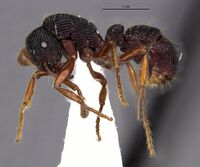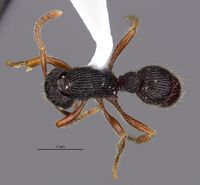Holcoponera aspera
| Holcoponera aspera | |
|---|---|

| |
| Scientific classification | |
| Kingdom: | Animalia |
| Phylum: | Arthropoda |
| Class: | Insecta |
| Order: | Hymenoptera |
| Family: | Formicidae |
| Subfamily: | Ectatomminae |
| Tribe: | Ectatommini |
| Genus: | Holcoponera |
| Species: | H. aspera |
| Binomial name | |
| Holcoponera aspera Morgan, Mackay & Pachero, 2003 | |
Collected from a litter sample from a montane evergreen forest.
Identification
Morgan et al. (2003) - A member of the strigata complex. The workers are medium sized, ranging from 3.0 to 4.5 mm in total length. The coloring on this ant is very interesting in that the costulae are dark brown on the edges while inside the folds the coloring is a deep red, rendering a mahogany color to the head, mesosoma and gaster. The legs are reddish brown, strongly contrasting with the remainder of the ant. The subpetiolar process is well developed with a poorly developed fenestra. The metacoxa has a well-developed tooth. The distinguishing character is the fine punctures on the costulate over her entire body, giving it a sequined look.
The worker of this species can be separated from most of the others in the genus, by the punctate costulae on all parts of the body. It can be separated from other members of the strigata complex by several characteristics: It is easily separated from Holcoponera bisulca (Costa Rica to Ecuador) by the lack the metanotal suture. The presence of costulae over the entire surface of the sternum of the postpetiole separates it from Holcoponera pittieri (Venezuela) in which the sternum is covered with weak, irregular rugae. It differs from Holcoponera ilimani by the presence of about five to seven, erect, coarse hairs on the scape, which are lacking (up to two may be present) in H. ilimani. It can be separated from Holcoponera andina (Columbia, Ecuador) as the fenestra on the subpetiolar process is poorly developed (very well developed in H. andina), and the punctated costulae, which are glossy and shiny in H. andina. Finally, H. strigata lacks the fine punctures on the costulae, which are all smooth and glossy. This new species could perhaps be confused with Gnamptogenys kempfi (Brazil, Columbia Peru), which also has fine punctures on the costulae (making the surface appear subopaque). It can be easily separated as the propodeum lacks spines (small teeth or angles are present on the propodeum of G. kempfi), and the metacoxal tooth is slender and slightly curved (straight and thickened in G kempfi). The costulae on the dorsum of the propodeum are longitudinal, whereas they are transverse in G. kempfi.
Keys including this Species
Distribution
Known only from the type locality in Bolivia.
Distribution based on Regional Taxon Lists
Neotropical Region: Bolivia (type locality).
Distribution based on AntMaps
Distribution based on AntWeb specimens
Check data from AntWeb
Countries Occupied
| Number of countries occupied by this species based on AntWiki Regional Taxon Lists. In general, fewer countries occupied indicates a narrower range, while more countries indicates a more widespread species. |

|
Estimated Abundance
| Relative abundance based on number of AntMaps records per species (this species within the purple bar). Fewer records (to the left) indicates a less abundant/encountered species while more records (to the right) indicates more abundant/encountered species. |

|
Biology
Castes
Worker
Nomenclature
The following information is derived from Barry Bolton's Online Catalogue of the Ants of the World.
- aspera. Gnamptogenys aspera Morgan, Mackay & Pacheco, 2003: 554, figs. 1-6 (w.) BOLIVIA.
- Type-material: holotype worker, 6 paratype workers.
- Type-locality: holotype Bolivia: Cochabamba, 109 km. E Cochabamba at Lagunitas; paratypes with same data.
- [Note: type-locality data ends abruptly at Lagunitas; it is suspected that a missing terminal section reads similar to, or the same as, that of flava: “17°6’22’’S, 65°40’57’’W, date, no. xxxx (R. Anderson)”.]
- Type-depositories: MCZC (holotype); IAVH, MZSP, WEMC (paratypes).
- Combination in Holcoponera: Camacho, Franco, Branstetter, et al. 2022: 11.
- Status as species: Camacho, et al. 2020: 456 (in key); Camacho, Franco, Branstetter, et al. 2022: 11.
- Distribution: Bolivia.
Unless otherwise noted the text for the remainder of this section is reported from the publication that includes the original description.
Description
Worker
Holotype in parentheses: HL 0.86-(0.96)-1.08; ML 0.50-(0.58)-0.62; HW 0.82-(0.91)-0.96; SL 0.72-(0.84)-0.90; ED (0.14)-0.1; EW 0.10-(0.12); WL 1.08-(1.20)-1.27; SSC 5-8 standing hairs. Indices: CI (89)-95; SI 86-(92)-94; OI 16-(19)-20; MI 69-(64)-65.
Mandibles triangular, with apical tooth curving down and inward toward head, mandibular margins meeting just in middle (no overlap); mandibles serrated with tiny teeth along masticatory, margin, apical being largerr than other teeth; clypeal margin rounded convexly with medial section protruding (Fig. 5), forming almost 90° angle at medial point; scape extends one diameter past posterior lateral margin of head; head oval- shaped; eyes medium sized, oval-shaped; promesonotal suture developed (Fig. 1), metanotal suture weakly apparent; petiole semicircular, posterior face flattened when viewed from above; subpetiolar process well developed; fenestra opaque; subpeduncular pro y-shaped when viewed from below (Fig. 2).
Integuement with longitudinal costulate on head, mesosoma, postpetiole and gaster; costulae in concentric circles on petiole when viewed from above (Fig. 4); surfaces of costulae covered with tiny punctures rendering a sequined look (Fig. 6).
Three to four long erect hairs along anterior margin of clypeus; scape with 5 to 8 erect hairs along dorsal surface, head with many long, erect hair in longitudinal rows curving toward frontal furrow; long erect hairs in longitudinal rows that continue on mesosoma, postpetiole, and gaster; petiole with erect hairs in concentric, circular rows as viewed from above.
The color is striking, depressions between costulae reddish-brown, surfaces dark brown, giving ant mahogany color; appendages medium brown distinctly contrasting with remainder of body.
Type Material
Holotype worker (deposited in the MCZ), Bolivia, Cochabamba, 109 km E Cochabamba at Lagunitas; 6 paratype workers, deposited in the collection of William and Emma Mackay, California Academy of Sciences, Instituto Humboldt (colobia), Instuto de Zoologia Agricola (Venezuela), and Museu de Zoologia da Universidade de Sao Paulo (Brazil).
Etymology
Latin from asperses meaning scattered or sprinkled, referring to the sculpture on the costulae.
References
- Camacho, G.P., Franco, W., Branstetter, M.G., Pie, M.R., Longino, J.T., Schultz, T.R., Feitosa, R.M. 2022. UCE phylogenomics resolves major relationships among Ectaheteromorph ants (Hymenoptera: Formicidae: Ectatomminae, Heteroponerinae): A new classification for the subfamilies and the description of a new genus. Insect Systematics and Diversity 6(1): 5; 1–20 (doi:10.1093/isd/ixab026).
- Lattke, J.E., Fernández, F. & Palacio, E.E. 2007. Identification of the species of Gnamptogenys Roger in the Americas (pp. 254-270). In Snelling, R.R., Fisher, B.L. & Ward, P.S. (eds). Advances in ant systematics: homage to E.O. Wilson – 50 years of contributions. Memoirs of the American Entomological Institute 80: 690 pp.
- Morgan, C.; Mackay, W.; Pacheco, J. 2003. A new Gnamptogenys of the striatula Group from Bolivia (Hymenoptera: Formicidae). Sociobiology 4(3):553-558. (page 554, figs. 1-6; map ; worker described)
References based on Global Ant Biodiversity Informatics
- Fernández F., and T. M. Arias-Penna. 2008. Las hormigas cazadoras en la región Neotropical. Pp. 3-39 in: Jiménez, E.; Fernández, F.; Arias, T.M.; Lozano-Zambrano, F. H. (eds.) 2008. Sistemática, biogeografía y conservación de las hormigas cazadoras de Colombia. Bogotá: Instituto de Investigación de Recursos Biológicos Alexander von Humboldt, xiv + 609 pp.
- Fernández, F. and S. Sendoya. 2004. Lista de las hormigas neotropicales. Biota Colombiana Volume 5, Number 1.


